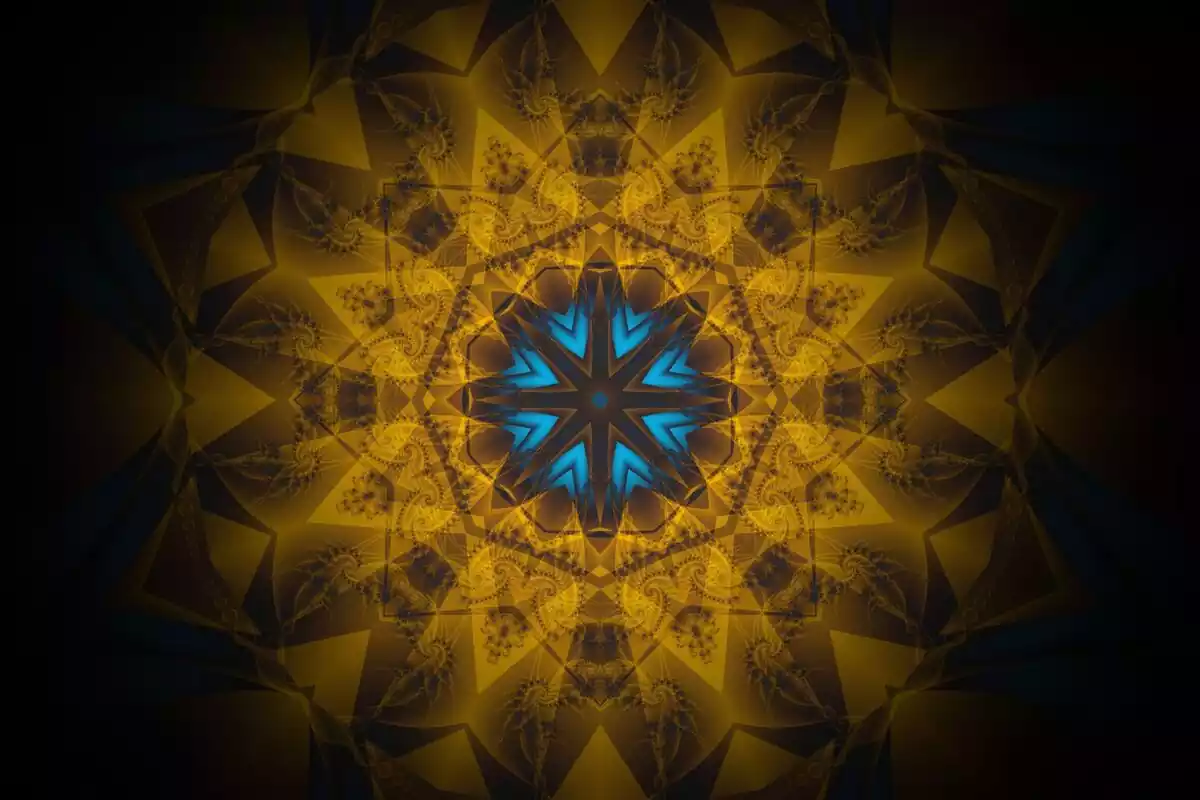The mandala has gained popularity recently due to its healing stress-reduction abilities. However, initially, this form of art was used in meditation by Buddhists and Hindus.
In this article we explain the meaning of the mandala and its function, considering both its traditional purpose in Asia, as well as in the present day. This, of course, all depends on the type of this design that is created and the shapes and colors used.
Finally, at the end of this text, you'll find 5 mandala coloring pages for your enjoyment. Some are suitable for children, while others are better for adults looking for stress relief.
What is a mandala?
In its most basic form, a mandala is a geometric pattern, usually a circle with a square inside of it and four gates. The presence of a structure that organizes and unifies the design around a central point is one of its distinguishing qualities.
Currently, the term 'mandala' is used to describe any kind of diagram or pattern representing the universe's configuration. In other words, the relationship between the macrocosm and microcosm intrinsic to human life. Below, we elaborate on the symbolism of this art form.
The name mandala and the popularity of this symbol come from Hinduism and Buddhism. However, very few people know that these patterns have also appeared in other cultures throughout history. For example, the Celts, Aztecs, Navajos, and even Christians have all created this design in one way or another.
These patterns are usually drawn and then colored, but sometimes they are also created using different methods. Keeping this in mind, some artists make sand mandalas out of colorful sand. Architecture, clothing, and other art forms also contain this pattern.
Mandala meaning
The word mandala means 'circle' or 'wheel' in Sanscrit. Its symbolism varies depending on the culture. However, meanings are often closely related in many cases, even if these art forms come from completely different parts of the world.
This is a symbol of the universe in Buddhism and Hinduism: these diagrams represent the structure of the cosmos and life. This design is a reminder of our relationship to the bigger picture, the infinite, the non-material, and the things that human beings are unable to perceive.
These designs depict the cycles that make up the microcosms. For example, families and communities, rebirth, samsara, and the celestial cosmos. This pattern appears repeatedly as a part of human life and in nature.
According to the psychoanalyst Carl Jung, the components and structure that the mandala is made up of, signify the fundamental essence of existence. Jung took a particular interest in finding similarities between myths and symbols present in different societies. This author also declared that this symbol enables individuals to take refuge within their inner beings and to come to terms with themselves and with the universe.
The symbolism of colors and shapes
The meaning of each one of these designs depends on the shapes and colors that form it. Those that choose to create mandalas can reflect on life experiences or their state of mind by combining different symbols in their creations.
Colors and shapes hold personal meaning, although they usually represent specific life experiences and concepts. However, no two are alike, and their significance is dependent on the perspective of the creator.
Here are some of the most common connotations behind the shapes found in mandala art:
Circle: unity, integrity, the universe, nature, entirety, the absolute, and the ego.
Square: balance, stability, security, creation, existance on the material plane.
Spiral: change, growth, learning, cycles, unity, healing.
Triangle: goals, aspirations, dreams, vision, transformation, vitality.
Flower: conscience, wisdom, purity, love, friendship.
As with shapes, the symbolism behind the colors of these patterns is both personal, yet universal:
White: divinity, perfection, light, purity, innocence, unity, attention.
Black: darkness, profoundness, individuality, secrets, mystery, death, sadness, ignorance.
Gray: neutrality, knowledge, peace, tranquility, suspense, renewal.
Purple: life, spirituality, intuition, wisdom, authority, nobility, intensity, contemplation, inspiration, idealism, magic.
Blue: love, relaxation, serenity, peace, satisfaction, compassion, truth, communication, happiness, emotional health.
Green: nature, peace, growth, renewal, hope, happiness, freedom, physical health.
Yellow: light, sun, power, learning, happiness, laughter, sympathy.
Orange: warmth, intensity, energy, self-consciousness, creativity, dynamism, bravery, ambition, tenderness.
Red: energy, life, action, passion, sensuality, strength, fire.
Pink: love, altruism, patience, sweetness.
What is its function?
Mandalas have many different uses. Depending on their beliefs, Buddhists and Hindus make use of these symbols in meditation, trances, or even to connect to the universe and divinity.
Drawing mandalas requires the artist to travel back to the moment that they want to depict. Delving into this process helps the artist to transmit experiences and feelings through the shapes and colors.
These designs often portray one's life up until the present moment. For this reason, people use this pattern to tell their life story and sequence of personal growth.
This symbol is also often created collectively to unite people, or to help a group of two or more to decide the direction that they want to move together in the future. This type of mandala is usually sewn or made with sand, although there is no right or wrong way of doing this, of course.
Coloring these patterns is a great way to wind down and destress in your free time. Also, this activity is even more beneficial if you choose to do it with the ones that you love the most.
Mandala coloring pages
Below we've included several mandala printables that you can color in or paint, keeping the goals that we mentioned in this article in mind.
There are all kinds of patterns suitable for both adults and children. You'll find everything from flowers to elephants, and even a turtle to color, for people of all ages.

